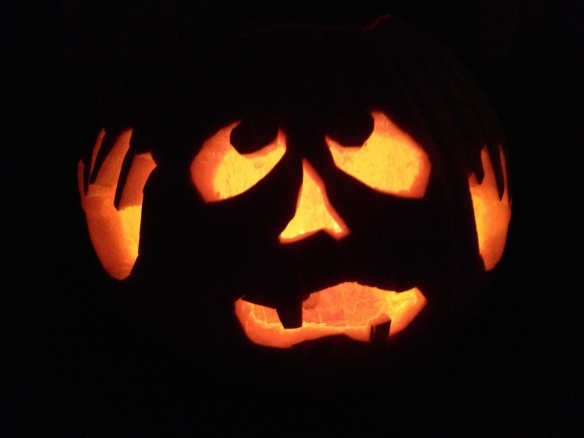The darkness of a room can be solved by a single candle.
–– Sebastian Barry, On Canaan’s Side[i]
Has there been a scarier Halloween in our lifetime? Evil powers are abroad, spreading terror and mayhem throughout the land. Will the flickering candles of our jack-o-lanterns be enough to ward them off?
Remember the “Night on Bald Mountain” sequence in Fantasia? The brooding mountain unfolds into a Satanic beast whose immense wings blot out the sky. The shadow of the beast flows like hungry lava over the land, swallowing everything in darkness, and releasing into the air ghoulish and malevolent forces we had thought to be safely buried in the tombs of history.[ii]
When I blogged my bleak forecast of a Trump presidency just before the 2016 election, I listed ten areas of concern. Sadly, my predictions were all too accurate. But they were also shockingly incomplete. I had not yet imagined my government abducting children from their parents and throwing those little ones into prison camps. I had not yet imagined a president turning a blind eye to the dismembering of a journalist out of a desire to sell weapons to a genocidal client. I had not yet imagined that neo-Nazis, racists and anti-Semites would be encouraged and enabled so openly and unashamedly by members of the governing party. In a week when Jesus got booed during a conference on religious freedom, perhaps I should not be that surprised anymore.
But as we mourn the slaughter of eleven Jewish souls who were praying in God’s house, it is hard not to be mad as hell. I want to share the Psalmist’s anger:
I am filled with a burning rage,
because of the wicked who forsake your law. [iii]
But merely to glare and fume at evil is to play its game. Entranced by its endless permutations, we may try to meet its every action with an answering counterforce. But as long as we do so, we will never escape its grasp. And we risk infection from the very darkness we hope to conquer. The best way to say no to evil is not to outshout it, but to walk in love, even in the Valley of the Shadow.
Simone Weil, in another dark and dangerous time, wrote a famous essay about the Iliad, whose true subject, she believed, was “force.”
“In this work, at all times, the human spirit is shown as modified by its relations with force, as swept and blinded by the very force it imagined it could handle, as deformed by the weight of the force it submits to. For those dreamers who considered that force, thanks to progress, would soon be a thing of the past, the Iliadcould appear as an historical document; for others, whose powers of recognition are more acute and who perceive force, today as yesterday, at the very center of human history, the Iliadis the purest and loveliest of mirrors.” [iv]
To call a reflection of humanity at its worst as the “loveliest of mirrors” may seem jarring, but for Weil the truth was always lovelier than self-deceit, for it liberates us from illusion and invites us to the makeover of grace. Mirror, mirror, on the wall . . .
When we look at the evils around us, do we only see the most visible perpetrators, or can we detect a deeper, more collective web of assumptions, feelings and actions in which we live and move and have our being? In reflecting on the hate crime at the Tree of Life, my friend Mark Harris, an artist/priest and thoughtful blogger, reminds us of what the ancient theologians called Original Sin: a persistent wrongness embedded in not only the psyche, but also the social fabric which precedes and transcends our personal agency. We may choose to resist or reject this wrongness as we become better conformed to our true humanity, but we can’t deny its existence or claim to be disentangled from it.
“I don’t think it is enough to talk about hate crimes,” Mark writes. “These are higher crimes, somehow more deeply embedded in the social fabric. These crimes are the strategic outcomes of those who form a social narrative in which the crimes are never traced to their source, but rather are left charged, if at all, to the immediate perpetrators. The manipulators of the social narrative hope to never get charged. And what’s more, WE hope never to be charged; in order to avoid having to be accountable, we too easily accept the verdict against the localized perpetrator as sufficient and bundle ourselves in the protection that ‘we’ are not to blame.” [v]
I hope I haven’t ignored my own advice here by talking more about the darkness than the light. What I really want to say is that yes, our flickering jack-o-lanterns of hope and love and kindness shall, in God’s good time, burn brighter than the darkest night, for they are part of the one Light which can never be overcome.
We may be daunted by the forces arrayed against everything good and true and beautiful. We may be shocked at how far things have sunk. We may grow weary of our own participation in the imperfections of history. But this train’s still bound for glory.
And this little light of mine? I’m gonna let it shine.
Photo and pumpkin carving by the author.
[i]Sebastian Barry, On Canaan’s Side (New York: Penguin Books, 2012), 70. A moving and beautifully written novel.
[ii]Thankfully, the dawn wins! You can view the sequence here: https://www.youtube.com/watch?v=SLCuL-K39eQ
[iii]Psalm 119:53
[iv]q. in Alan Jacobs, The Year of Our Lord 1943: Christian Humanism in an Age of Crisis(Oxford: Oxford University Press, 2018), 93.
[v]Mark Harris, “Kilers, hate crimes, and unholy violence,” Episcopal Café(October 29, 2018): https://www.episcopalcafe.com/killers-hate-crimes-and-unholy-guidance/ Mark’s blog on Anglican/Episcopal matters is Preludium.


